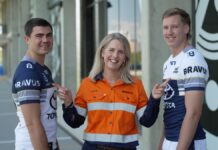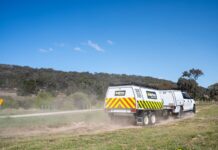Over the past decade, engine and turbo technology have increased in complexity and decreased in size as vehicles have been designed, and redesigned, to meet emissions regulations.
And where previously, the precision of the settings of the sensitive mechanisms in variable nozzle (or variable geometry) turbochargers was important, it is now absolutely paramount to be accurate.
If you want a turbo to operate efficiently, or in fact at all, you cannot guess at the vane setting position for air flow, or risk catastrophic vibrations with an unbalanced core assembly.
The Australian Mining Review spoke to GCG Turbos director Brett Lloyd to get the lowdown on building and maintaining these highly sensitive set-ups.
According to Brett, the average turbo repair facility will use static rotor balancing, but this fails to pick up the minute sonic imbalances that can happen between the turbine and compressor ends of the turbocharger.
But there is technology available that is so precise it can produce a balance that is comparable to the original manufacturer’s settings.
GCG operates the most technologically advanced turbocharger service facility in Australia, looking after everything from motorbikes right through to 250 tonne dump trucks.
“This technology has really only become available to us in the last 10 years,” Brett said.
“Prior to that everyone was doing the same sort of rotor balancing and field gauge measurements and all that sort of thing, but it’s much more technical than that now.
“If you don’t have this sort of equipment, you’re not really doing justice to a turbocharger rebuild.”
The Right Balance
All objects that rotate around a centre axis have a certain amount of unbalance which creates a resonant frequency (natural frequency of vibration) at a specific rpm.
Traditionally, turbo rotors were balanced at lower speeds, like a tyre shop balances a car wheel.
At low speed, you can achieve a level of balance accuracy because the resonant frequency of the rotor is higher than the operating speed of the turbo.
But as turbos became smaller, rotational speed increased significantly.
A turbo core assembly can reach rotational speeds of more than 230,000rpm (3800 revolutions per second), which means it passes through resonant frequencies within its operating range.
These vibrations, however small, can be magnified enough to damage a turbo or cause catastrophic failure.
To ensure the core assemblies of modern turbochargers do not vibrate excessively, they need to be balanced on a high speed machine which accelerates the core assembly through its full operating speed and measures the vibration as the rotor passes through resonant frequencies.
“A turbo VSR, or vibration sorting rig, basically takes the centre core of the turbocharger, the assembled middle section which includes both impellers, and using a simulated exhaust and compressor housing and sensing, spins the turbocharger at the operational RPM with the oil pressure passing through it,” Brett said.
“It uses exactly the same software, exactly the same parameters, as the manufacturers use.
“Once we’ve finitely balanced it, we take the turbocharger core assembly off the rig and the information is all documented and traceable.”
Brett said supplying each turbocharger’s reports to validate its VSR balance was particularly useful to the mining industry where documentation and accountability is imperative.
Going With The Flow
It takes more than a good balance for a turbocharger to operate at its best.
A turbo needs to be set correctly so that it produces the correct boost pressure as the engine speed and power demand changes.
Variable Nozzle Turbochargers are great at reducing the effects of turbo lag, resulting in better torque and more responsive acceleration especially at low speed.
They work by changing the speed and direction of the exhaust gases onto the turbine wheel.
But when the boost pressure is wrong, both engine performance and emissions suffer, and the OBD (On-Board Diagnostic) system might detect a problem that results in an ECU (Engine Control Unit) shutdown putting the vehicle into limp-home mode.
Flow tests measure and adjust the mass air flow through a turbo.
At GCG, after balancing, the core assembly is put together with its two housings and the turbocharger goes onto a flow bench.
“The turbocharger flow bench can actually measure exhaust pressures, exhaust flow, compressor pressures, and compressor flow, and will allow us to, in the case of an electronically actuated turbo, set the boost pressures, versus the turbo RPM,” Brett said.
“And for a variable vane turbo, you can set the vane into the same position as it would have been when it left the factory.
“Again, the data that’s stored inside our flow rig is the same data that the manufacturers use when they’re building these things in a production facility.”
Pressure Test
The final process finds the turbocharger on a static oil pressure test rig facing seven bar oil pressure to make sure that it’s sealed on both ends and there are no leaks.
“When the turbocharger goes back to the customer, either repaired or a new build, to OEM spec, it meets all the criteria of the manufacturer,” Brett said.
GCG has invested heavily in service technology, installing vibration sorting rigs, turbo flow, benches, oil pressure tests, and numerous electronic turbocharger actuation testing and setting machinery.
And ever-evolving, the company is expanding its DPF (Diesel Particulate Filter) cleaning offering with the addition of ultrasonic and hydrocarbon cleaning machines.
“We’ve identified DPF in the last five years as a definite growth opportunity, with a lot of the current fleet on the road, be it commercial or passenger cars running DPS, and in the next generation GPFs (Gasoline Particulate Filters),” Brett said.
Meeting Demand
There are seven major turbocharger manufacturers in the world, servicing almost 100 per cent of the demand.
Brett said all turbochargers were made by a third party, not the actual vehicle or engine manufacturers.
“We’re representing those manufacturers of turbochargers here in Australia as their authorised distributor and their authorised service centre, which is a little bit different because some people are authorised distributors, but not authorised service centres,” he said.
Providing both sales and service was key to GCG’s success during the uncertainty of the last 18 months.
In fact a major gamble at the beginning of the COVID-19 outbreak paid off for the company, which is now reaping the benefits of being able to supply Australia’s growing demand for turbochargers and parts.
“One of the things we did, rightly or wrongly – my accountant hated me – when COVID first started back in, 2019 and early 2020, was that we actually ramped up inventory,” Brett said.
“We actually said. Well. the world’s going to hurt from this and we’re not going to be able to get anything, so we will ramp up.
“We put about $1.8m worth of additional stock on the shelf just to try to see us through the first part of COVID . . . and it’s probably paid dividends in the fact the market in Australia hasn’t slowed down, it’s actually sped up.
“We found ourselves with good inventories and being able to meet, I would say, 80% of customer demands.”
Keep On Trucking
Although executing deliveries across the country is a little technically challenging at the moment, GCG is still able to manage next day delivery on most items from its two warehouses in Sydney, and is actively looking for a facility in Melbourne.
Fast turnaround is vital for the mining industry, but exchange programs make life easier when breakdowns happen.
GCG has generic exchange programs for common turbos like those in the CAT 15 diesel engine, but also does in-house programs for specific fleet requirements where the customer carries some shelf stock and GCG backs them up with support stock.
Delays are kept to a minimum and the trucks keep trucking.
“They call on their shelf stock, we replenish ours, and everyone is happy, the job gets done as quickly as possible at their time of need,” Brett said.
From the mining industry to the military, from small transport companies to Sydney Ferries, GCG Turbos has been selling and servicing Australia’s turbochargers since 1979.
Family Values
GCG was a family-owned business, founded by Brett’s father Colin.
“We started as a repair facility for turbochargers but back in the late 70s the business evolved from there to being a distribution hub for all manufacturers,” Brett said.
And the company has expanded overseas with a sales and service hub in Japan and recently stepping into Korea with sales; and as soon as restrictions allow, Brett will be there to set up the service division.
“We supply the genuine product, from the same places that supply vehicle and engine manufacturers, but we provide an aftermarket route to trade here in Australia,” Brett said.
“The beauty of it is that we sell the highway product, we have direct access to the manufacturer, we get the best price and you make savings.”
The philosophy of the company is simple, it exists to solve customers’ problems.
“A customer rings us because they need a solution and we need to give them a solution,” Brett said.
“Some things are so old, or something is so unique that we don’t have a new one to sell to them, but our aim is to give the customer a solution and that might be that we need to repair the turbocharger instead.
“Basically we’re available to help any customer that rings us.”
That’s a lot of customers, and a lot of turbos, with GCG supplying and servicing Australia’s mining giants and many capital city transport services. All the busses in Sydney for example, have turbochargers.
“We’re always getting customer feedback, people taking the time to write me an email and thank us for the service we’ve given them,” Brett said.
SOURCE
GCG Turbochargers
P: 1300 TURBOS (1300 887 267); Int: +61 2 9708 2122
E: Sales/Technical – online@gcg.com.au
Customer Support – online@gcg.com.au
Workshop/Service – workshop@gcg.com.au
W: gcg.com.au





















